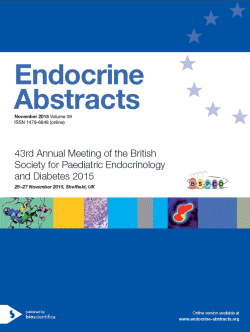
43rd Meeting of the British Society for Paediatric Endocrinology and Diabetes
e-Posters
Miscellaneous/other
ea0039ep79 | Miscellaneous/other | BSPED2015
The not so sweet truth of paediatric hypoglycaemia
Ramsden Louise , Wright Katherine , Natarajan Anuja
ea0039ep80 | Miscellaneous/other | BSPED2015
Volumetric changes in the hippocampus and relationship to memory indices in children with hyperinsulinaemic hypoglycaemia and ketotic hypoglycaemia
Kumaran Anitha , Bullock Jemima , Kapoor Ritika , Chong Kling , Gadian David , Vargha-Khadem Faraneh , Hussain Khalid
ea0039ep81 | Miscellaneous/other | BSPED2015
Pilot study on the utility and acceptability of video animation as a delivery method for educational materials for families and carers of patients with congenital hyperinsulinism in infancy
Rodgers Elizabeth , Rigby Lindsey , Dunne Mark , Banerjee Indraneel , Cosgrove Karen
ea0039ep82 | Miscellaneous/other | BSPED2015
Development of a feasible intervention to support communication with young people
Callery Peter , Downing Jenny , Gleeson Helena , Clayton Peter , Davis Julian , Dimitri Paul , Wales Jerry , Young Bridget
ea0039ep83 | Miscellaneous/other | BSPED2015
Determination of pancreatic hormones in children with different forms of hyperinsulinaemic hypoglycaemia
Guemes Maria , Morgan Kate , Gilbert Clare , Rahman Sofia , Hussain Khalid
ea0039ep84 | Miscellaneous/other | BSPED2015
Congenital hyperinsulinism due to SUR1 (ABCC8) mutation in newborn twins: improvement of clinical outcome after eight years follow-up
Ersoy Betul , Tansug Nermin , Genc Abdulkadir , Kizilay Deniz , Kiremitci Semiha , Ayhan Semin , Lonlay Pascale D E
ea0039ep85 | Miscellaneous/other | BSPED2015
Digenic mutation resulting in a rare form of diazoxide responsive congenital hyperinsulinism
Giri Dinesh , Flanagan Sarah E , Ellard Sian , Didi Mohammed , Senniappan Senthil
ea0039ep86 | Miscellaneous/other | BSPED2015
The use of glucagon in the treatment of hypoglycaemia due to congenital hyperinsulinism
Jadawji Chandni , Estebanez Maria , Padidela Raja , Bowden Louise , Rigby Lindsey , Kinzell John , Cosgrove Karen , Dunne Mark , Banerjee Indraneel
ea0039ep87 | Miscellaneous/other | BSPED2015
An incidental finding of an abdominopelvic macrocystic lymphangioma in a girl with Turners syndrome
Bhandari Jasjit Kaur , Nathwani Nisha
ea0039ep88 | Miscellaneous/other | BSPED2015
Usefulness of bedside ketone testing in the evaluation of children with hypoglycaemia
Alsaffar Hussain , Phanse Supriya , Collingwood Catherine , Didi Mohammed , Senniappan Senthil
ea0039ep89 | Miscellaneous/other | BSPED2015
Isolated postprandial hyperinsulinaemic hypoglycaemia in children
Guemes Maria , Melikyan Maria , Senniappan Senthil , Hussain Khalid
ea0039ep90 | Miscellaneous/other | BSPED2015
Case of raised creatinine in a newborn with congenital hyperinsulinism: diazoxide induced acute kidney injury
Godinho Felvira , Lewin Rebecca , Park Julie , Losa Ignatius



